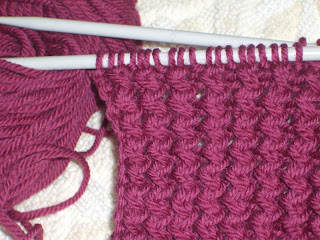My most recent history with the white lace shawl tempted me to title this one "Blockhead!" After all, I broke most of the principles of knitting (not counting, wrong needle, etc.) and then moved blithely along under my own smug steam, believing I was working all stitches and patterns correctly. Blockhead!
Blocking is the correct term for the next step in the Swatch process. I have to prepare each swatch to be seen and/or used (as if each were a piece of a garment, to be sewn into a sweater, or vest, or armor.) Words like '
shaping' and
'finishing' are also used, so if you're searching for help in somebody's book, look for any of the three words.
The idea is to shape the piece, adjust the stitches, even things out, smooth the surface without pressing it flat, and in all ways you can imagine make the swatch suitable for a viewing by the Royal Family of TKGA -- aka the knitting judges.
I've blocked 6 of the swatches, using a spray bottle of cool water, some pins, and several of the interlocking blocking shapes.
 |
Each of these 6 swatches has been sprayed and pinned
down, then picked over to fix wayward stitches. |
The Level I Master Knitter Designation requires a term paper about blocking, complete with bibliography. I've blocked a few sweaters and scarves over the years, but -- away, ye smugness, away! So I sat down with a pile of books and read and made notes. On paper and in my mind I was organizing the paper I will finalize. Right now it's in outline form, with a few special cautionary notes to include. Lots of study, and more than you really wanted to know about blocking.
 |
In addition to the books in this picture, I read several
articles from past issues of the TKGA member magazine,
Cast On. |
Then I gathered the supplies I would need.
 |
The spray bottle looks like it's upside down; it's not.
It's lying on the blocking board amidst the tape
measure, pins, and omnipresent stickies. |
Here's the before view -- the swatch is curled at the edges and sloppy looking. Not good for much of anything. Some knitters avoid the blocking step because it's time-consuming and can be tiresome. But ignore at your peril, my knitting friends. Without blocking your work, you will very likely be disappointed in the final item / garment. End of lecture (besides, each of the books has the same lecture.)
 |
This is the backside. This view is the most dramatic presentation
of the curling edges. Also note, I have not yet woven in
those pesky tails -- each of which must disappear into
the fabric prior to blocking. Groan. |
And when it's on the board, it looks wonderful.
 |
This is Swatch 1 (not the one in the picture showing the curling
edges) as it appears on the blocking board. The edges are anchored
with pins, carefully so as not to make scalloped edges. |
I've fussed with each swatch. I've pushed and adjusted individual stitches. I've used the tapestry need to loosen the too-tight and tighten the too-loose. I've been as particular as my patience and afternoon mood would allow, thinking all the time that "they are gonna be looking at this thing stitch by bloody stitch so it had better be the best I can make it."
And now it's time for a confession (as if this self-absorbed blog hasn't already alluded to a few mistakes and some sassy attitude): I really am enjoying this challenge. I am enjoying working on my knitting with intention, with the idea that I will learn something, and with a sense of purpose that, no matter the designation, will surely result in much improved knitting.
Now how's
that for a life lesson, ladies and gents.

















































